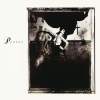
One of the characteristic qualities of a lot of Billie Eilish mixes is the way they manage to create a subjectively hard-hitting pop/EDM impression despite the essential fact that her vocal timbre is quite delicate, relying a great deal on ASMR-grade intimacy and breathiness. If you listen to a lot of her uptempo songs, you’ll hear that much of the backing is therefore actually quite dull-sounding, thereby leveraging the power of mix constrast to give the sense that Eilish’s voice is super-breathy and upfront, rather than relying on the massive injections of HF enhancement that many EDM producers fall back on. As a result, listeners can readily turn her records up loud enough to disassemble cheaper items of Ikea furniture without the mix’s upper spectrum ever getting fatiguing. Indeed, I was stood about 30 feet from the front of one of her big festival gigs last summer, and was impressed how easy her sound was on my ears compared with many of the other artists I heard from that vantage point – it was actually one of the very few shows that I felt able to listen to without earplugs!
Of course, it’s rarely possible to completely eliminate high end from your backing tracks without making the production as a whole sound muffled, and drum parts in particular often provide a kind of tonal frame of reference for the listener in this respect, so it’s interesting to hear how Eilish navigates this in her recent hit ‘Lunch’ – especially as the song helpfully ends with a couple of almost completely isolated bars of the main beat, which makes it easier to analyse! What’s particularly characteristic about this drum sound is that the brightness of each kick, snare, clap, and hi-hat is primarily concentrated right at the start of the hit. These provide a cue to the listener that the drums (and the production as a whole) have an appropriate upper-spectrum balance, but at the same time aren’t nearly as fatigung on the ear at higher playback volumes as more sustained high-frequency sounds like hissy cymbal hits or fizzy distorted guitars. In fact, if I use the outro’s isolated beat to phase-cancel those little transients out of a section of the song, it’s surprising how much overall brightness the production seems to lose. Transients In: play_arrow | get_app Transients Out: play_arrow | get_app It’s not a new trick, this, to be fair – I wrote about something similar going on in Miley Cyrus’s 'Midnight Sky' a few years back, for instance, but it nevertheless feels to me like a bit of an Eilish hallmark these days.
But there’s something else worth highlighting about this drum beat that relates to a recent Cambridge-MT patron Q&A response I wrote to the question ‘How can I fix a plodding groove?’, because this production is a classic example of a beat which very much skips along by virtue of two important programming features. Firstly, the main quarter-note beats are heavily favoured over the eighth-note off-beats in the balance – the quarter notes are both much meatier in tone and louder in the mix balance. And, secondly, the programmer has resisted the temptation to add further metric subdivisions (in this case sixteenth notes) to the programming, which is something that can quickly make a beat feel like it’s becoming more sluggish. Yes, a sixteenth-note tambourine does appear during the outro, which could have been risky, but even if this hadn’t been at a point in the song where the groove’s momentum was already well established, the tambourine’s potential for groove-dampening is also mitigated by the heavier four-to-the-floor kick pattern adding further emphasis to the main quarter-note beats at that point, and the fact that the tambourine not only appears fairly low in the mix balance again, but also itself significantly favours its eighth-note beats over the sixteenth-note subdivisions.










